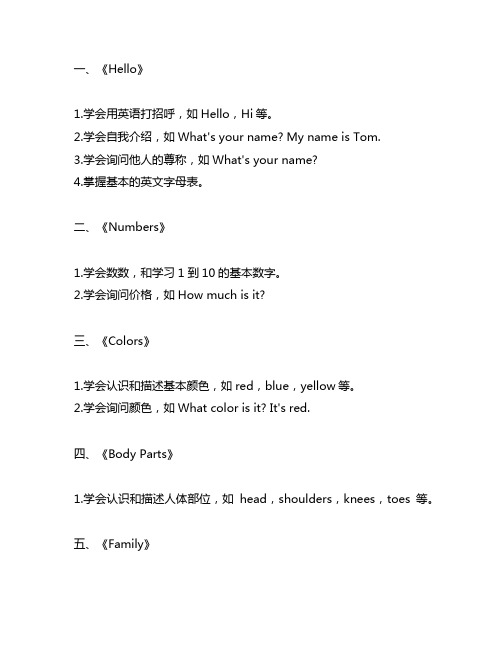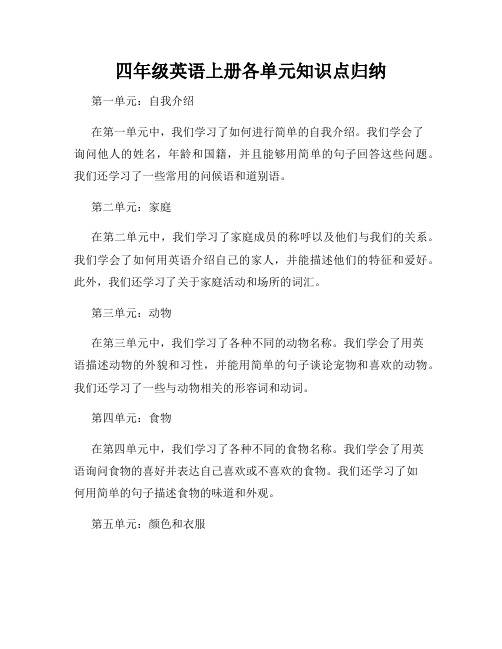小学四年级英语上册各单元知识点归纳
[全]人教版小学英语四年级上册单元知识点
![[全]人教版小学英语四年级上册单元知识点](https://img.taocdn.com/s3/m/3ffe57f6c850ad02df80411e.png)
人教版小学英语四年级上册单元知识点第一单元Unit 1 My classroom一、核心词汇常见物体名称:classroom教室window窗户blackboard黑板light电灯picture图画door门teacher’s desk讲台computer计算机fan风扇wall 墙壁floor地板二、了解词汇1.其他:TV电视really(表示兴趣或惊讶)真的near距离近clean打扫help帮助2.常见的方位介词:in在……里面on在……上面under在……下面三、核心句型1.Wehaveanewclassroom.我们有间新教室。
解读:“Wehave…”意为“我们有……”。
拓展:此句中主语为第一人称复数形式,故谓语动词用have;当主语为第三人称单数形式时,谓语动词用has。
2.Let’sgoandsee!我们去看看吧!解读:let’s是letus的缩写形式,但let’s是包括听话者在内的“我们”,letus 不包括听话者。
3.—Whereisit?它在哪儿?—It’snearthewindow.就在窗户旁边。
解读:where用来询问物体或人的位置或方位。
回答时用in,on,under,near等方位介词。
4.What’sintheclassroom?教室里有什么?解读:这是询问某处有什么的句型,其中what’s是whatis的缩写形式。
拓展:想知道某物上面/下面/附近有什么,可以用“What’son/under/near+名词?”来提问。
5.Let me clean the windows.我来擦窗户。
解读:me是I的宾格形式。
letme后面要接动词原形。
四、了解句型1.Openthedoor.开门。
2.Turnonthelight.打开灯。
3.Closethewindow.关窗户。
4.Putupthepicture.张贴图画。
5.Cleantheblackboard.擦黑板。
6.Thedoorisorange.门是橘黄色的。
四年级上册英语一到三单元知识点

四年级上册英语一到三单元知识点以下是四年级上册英语一到三单元的知识点:Unit 1: My Family•家庭成员的称呼:father, mother, brother, sister, grandmother, grandfather, uncle, aunt等。
•家庭成员之间的关系:爸爸是家庭的头,妈妈照顾家庭,兄弟和姐妹互相帮助,祖父母和外祖父母给予爱和关心,叔叔和阿姨是家庭的亲戚。
•描述家庭成员的外貌特征、性格、爱好等。
Unit 2: My School Life•学校的名称、位置、建筑等。
•学校的校规和课程设置。
•老师和同学的角色和关系。
•上课时间、下课时间和午餐时间等。
•课堂上的学习活动,如听讲、讨论、做练习等。
Unit 3: My Hobbies•各种爱好的定义和特点,如读书、画画、跳舞、唱歌、打球等。
•自己的爱好和喜欢的原因。
•如何发展和坚持自己的爱好,如参加兴趣班、结交志同道合的朋友等。
四年级上册英语一到三单元知识点解析assistant avatarUnit 1: My Family本单元主要围绕家庭成员展开,学生需要掌握以下知识点:家庭成员的称呼。
学生需要掌握常用的家庭成员称呼,如father, mother, brother, sister, grandmother, grandfather, uncle, aunt 等。
家庭成员之间的关系。
学生需要了解家庭成员之间的相互关系和角色,如爸爸是家庭的头,妈妈照顾家庭,兄弟和姐妹互相帮助,祖父母和外祖父母给予爱和关心,叔叔和阿姨是家庭的亲戚等。
描述家庭成员的外貌特征、性格、爱好等。
学生需要学会用英语描述家庭成员的外貌特征、性格、爱好等,如My father has short hair and wears glasses. He is very smart. My mother is kind and beautiful. She likes cooking.Unit 2: My School Life本单元主要围绕学校生活展开,学生需要掌握以下知识点:学校的基本信息。
人教版四年级上册英语各单元知识点总结

一、《Hello》1.学会用英语打招呼,如Hello,Hi等。
2.学会自我介绍,如What's your name? My name is Tom.3.学会询问他人的尊称,如What's your name?4.掌握基本的英文字母表。
二、《Numbers》1.学会数数,和学习1到10的基本数字。
2.学会询问价格,如How much is it?三、《Colors》1.学会认识和描述基本颜色,如red,blue,yellow等。
2.学会询问颜色,如What color is it? It's red.四、《Body Parts》1.学会认识和描述人体部位,如head,shoulders,knees,toes等。
五、《Family》1.学会认识家庭成员,如father,mother,brother,sister等。
2.学会询问他人的家庭成员,如How many people are there in your family?六、《Animals》1.学会认识和描述一些常见的动物,如cat,dog,bird,fish等。
2.学会询问他人是否喜欢动物,如Do you like animals?七、《Fruit》1.学会认识和描述一些水果,如apple,banana,orange,grape等。
2.学会询问他人喜欢的水果,如What fruit do you like?八、《Snacks》1.学会认识和描述一些零食,如chips,cookies,candy,chocolate 等。
2.学会询问他人喜欢的零食,如What snacks do you like?九、《Clothes》1.学会认识和描述一些常见的服装,如T-shirt,pants,shoes,hat等。
2.学会询问他人穿着的衣服,如What are you wearing today?十、《D本人ly Routines》1.学会描述日常的生活习惯,如get up,go to school,have lunch,do homework等。
人教版小学四年级上册英语知识点归纳

人教版小学四年级上册英语知识点归纳四年级上册知识点总结 Unit 1 My Friends一、词汇:窗户、黑板、灯、图画、门、地板、教室、计算机、讲台、墙、电扇。
二、句型:1、教室里面有什么?许多课桌和椅子。
2、让我们一起打扫教室吧。
①好。
②好主意。
③好的。
3、我的座位在哪里?它在门的附近。
4、看那幅图画。
它很好看。
5、我们有一个室。
让我们一起去看看吧。
它很大,墙是白色的。
6、让我来擦窗户。
做得好!三、语法:1、Where 引导的特殊疑问句:看到 where 就要想到地点方位词,例如:on。
in。
under。
near。
behind 等。
2、Let’s = Let us 让我们Let me 让我特殊疑问句例句:1、你叫什么名字?2、你爸爸是干什么的?3、你的盒子里是什么?4、北京的天气怎么样?5、现在几点了?6、这双鞋子怎么样?7、你呢?1.I'm XXX.2.How many cups of milk do you need。
Three.3.Excuse me。
where is the nearest bookshop?4.What is your father's job?5.How are you。
- Fine。
thanks.6.How much is it。
Five yuan.Unit 2: My SchoolbagVocabulary: Chinese book。
English book。
maths book。
schoolbag。
storybook。
XXX。
candy。
XXX.XXX:1.How many books do you have。
- I have six。
/ Six.2.I have a new schoolbag。
- What colour is it。
- It's black and white.3.May I have a look。
- Sure。
四年级上册英语各单元知识点整理

四年级上册英语各单元知识点整理Unit 1 My classroom词汇:window窗户 board 写字板 light 灯 picture 图画 door 门 floor 地板 classroom教室 puter 计算机teachers desk 讲台 wall 墙 fan电扇句型:1、Whats in the classroom 教室里面有什么Many desks and chairs. 许多课桌和椅子。
2、 Lets clean our classroom .让我们一起打扫教室吧① OK. 好。
② Good idea . 好主意。
③ All right .好的。
3、Wheres my seat 我的座位在哪里Its near the door.它在门的附近。
4、Look at the picture .看那幅图画。
Its nice .它很好看。
5、We have a new classroom,.我们有一个新教室。
Lets go and have a look.让我们一起去看看吧。
Its so big.它很大。
The wall is white.墙是白色的。
6、Let me clean the window.让我来擦窗户。
Good job!做得好!Unit 2 My schoolbag词汇:Chinese 语文 English 英语 math 数学schoolbag书包story-book故事书 notebook笔记本 twenty二十twenty-one二十一thirty 三十 forty 四十 fifty五十(必须能写) bag pencil pen book ruler pencil-case书包铅笔钢笔书本尺子铅笔盒句型:1、 How many books do you have 你有几本书① I have 6 .我有6本。
② Six .6本2、I have a new schoolbag.我有一个新书包。
四年级英语上册各单元知识点归纳

四年级英语上册各单元知识点归纳第一单元:自我介绍在第一单元中,我们学习了如何进行简单的自我介绍。
我们学会了询问他人的姓名,年龄和国籍,并且能够用简单的句子回答这些问题。
我们还学习了一些常用的问候语和道别语。
第二单元:家庭在第二单元中,我们学习了家庭成员的称呼以及他们与我们的关系。
我们学会了如何用英语介绍自己的家人,并能描述他们的特征和爱好。
此外,我们还学习了关于家庭活动和场所的词汇。
第三单元:动物在第三单元中,我们学习了各种不同的动物名称。
我们学会了用英语描述动物的外貌和习性,并能用简单的句子谈论宠物和喜欢的动物。
我们还学习了一些与动物相关的形容词和动词。
第四单元:食物在第四单元中,我们学习了各种不同的食物名称。
我们学会了用英语询问食物的喜好并表达自己喜欢或不喜欢的食物。
我们还学习了如何用简单的句子描述食物的味道和外观。
第五单元:颜色和衣服在第五单元中,我们学习了不同的颜色和各种不同的衣服。
我们学会了用英语询问颜色并描述衣服的样式和颜色。
我们还学习了一些与服装相关的词汇和简单的购物用语。
第六单元:学校生活在第六单元中,我们学习了学校里的常见物品和活动。
我们学会了以句型“What's in/ on/ under/ behind + 物品” 来描述物品的位置和方位关系。
我们还学习了一些与学校相关的动词和名词。
第七单元:职业在第七单元中,我们学习了各种不同的职业名称。
我们学会了用英语询问和回答有关职业的问题,并能描述职业的特点和工作内容。
我们还学习了一些与职业相关的动词和名词。
第八单元:季节和天气在第八单元中,我们学习了四个季节以及不同季节的天气。
我们学会了用英语询问天气并描述天气情况。
我们还学习了与季节和天气相关的形容词和名词。
第九单元:交通工具在第九单元中,我们学习了各种不同的交通工具名称。
我们学会了用英语询问交通工具的用途,并能描述交通工具的特点和出行方式。
我们还学习了一些与交通工具相关的动词和名词。
部编英语四年级上册各课重点考点知识点总复习归纳整理
部编英语四年级上册各课重点考点知识点总复习归纳整理第一单元:My Classroom重点考点1:B铅笔盒物品类词汇- Pencil box 铅笔盒- Pencil 铅笔- Eraser 橡皮- Ruler 尺子- Glue stick 胶棒- Scissors 剪刀- Book 书- Bag 包重点考点2:A教室物品类词汇- Classroom 教室- Desk 课桌- Chair 椅子- Window 窗户- Blackboard 黑板- Door 门- Teacher's desk 教师讲台- Projector 投影仪重点考点3:一般疑问句- What's this? 这是什么?- What's that? 那是什么?- It's a/an... 它是一...第二单元:My School重点考点1:学校场所类词汇- Playground 操场- Library 图书馆- Music room 音乐室- Art room 美术室- Sports room 体育室- Office 办公室重点考点2:一般现在时- I go to school by bus. 我乘公交车去学校。
- She has lunch at 12:00. 她中午12点吃午饭。
- We are teachers. 我们是老师。
重点考点3:介词短语- Go to... 去...- Have lunch... 吃午饭...- Play sports... 做运动...第三单元:My Family重点考点1:家庭成员词汇- Father 父亲- Mother 母亲- Sister 姐妹- Brother 兄弟- Grandfather 祖父- Grandmother 祖母- Grandpa 外公- Grandma 外婆- Cousin 表亲重点考点2:一般疑问句- Who's this? 这是谁?- Who's that? 那是谁?- He's/She's... 他是/她是... 重点考点3:职业类词汇- Doctor 医生- Teacher 教师- Policeman 警察- Fireman 消防员- Driver 司机- Nurse 护士第四单元:Body Parts重点考点1:身体部位词汇- Head 头- Eye 眼睛- Ear 耳朵- Nose 鼻子- Mouth 嘴巴- Arm 手臂- Hand 手- Leg 腿- Foot 脚重点考点2:一般疑问句- Have you got...? 你有...吗?- Yes, I have. / No, I haven't. 是的,我有。
四年级英语上册重点笔记归纳
四年级英语上册重点笔记归纳第一部分:单词1. 表示颜色的词:red,green,blue,yellow,white,black等。
2. 动物单词:cat,dog,bird,fish,tiger,panda等。
3. 人体部位单词:head,face,nose,eye,mouth,ear 等。
4. 职业相关单词:teacher,student,worker,doctor,nurse等。
5. 数字单词:one,two,three,four,five等。
6. 食物单词:apple,banana,orange,bread,rice等。
7. 表示时间的词:morning,afternoon,evening,night 等。
第二部分:语法1. 一般现在时:表示经常发生或习惯性的动作或状态。
基本结构是主语+be动词+动词-s或主语+动词-s。
2. 现在进行时:表示正在进行的动作或状态。
基本结构是主语+be动词+动词-ing。
3. 疑问句和回答疑问句:一般疑问句以助动词do或does开头,回答用yes或no;特殊疑问句以what,where,who等疑问词开头,回答根据实际情况回答。
4. 祈使句:表示请求、命令或建议的句子。
以动词原形开— 1 —头,常以please结尾。
5. 名词复数形式:大部分名词后面加上s或es构成复数形式。
6. 名词所有格:表示名词所有关系时使用所有格形式。
基本结构是名词+’s或名词+of+名词。
7. 介词用法:常见的介词包括in,on,at等。
表示时间时,in表示在一个时间范围或接年、月、季节等;on表示在具体某一天或具体某一天的上午、下午或晚上;at表示在具体某一时刻。
8. 可数名词和不可数名词:可数名词有复数形式,可以计数;不可数名词没有复数形式,不能计数。
9. 动词过去式:表示过去发生的动作或状态。
基本结构是动词原形加上ed或d。
— 2 —。
四年级英语上册重点知识归纳
四年级英语上册重点知识归纳四年级英语上册重点知识归纳:一、单词:1. 人称代词(主格):I(我),you(你),he(他),she(她),it (它),we(我们),you(你们),they(他们)。
2. 形容词性物主代词:my(我的),your(你的),his(他的),her (她的),its(它的),our(我们的),your(你们的),their(他们的)。
3. 名词性物主代词:mine(我的),yours(你的),herses(她的),his(他的),its(它的),ours(我们的),yours(你们的),theirs (他们的)。
4. 介词:in(在……里面),on(在……上面),under(在……下面),behind(在……后面)。
5. 指示代词:this(这个),that(那个)。
6. 方位介词:in front of(在……前面),behind(在……后面),next to (在……旁边)。
7. 序数词:first,second,third,fourth,fifth,sixth,seventh,eighth,ninth,tenth。
8. 特殊疑问词:what(什么),why(为什么),when(什么时候),where(哪里)。
二、句子:1. 询问对方或其他人正在做什么事情的句型:“What are you doing?”或“What is he/she doing?”。
2. 询问对方或其他人正在看什么、喜欢什么、想要什么等事物的句型:“What are you looking at?”或“What does he/she like?”。
3. 询问对方或其他人是否能够做某件事情的句型:“Can you do sth?”或“Can he/she do sth?”。
4. 表示“感谢”的句型:“Thank you for sth./doing sth.”。
5. 表示“再见”的句型:“Goodbye!”。
四年级上册英语知识点归纳总结
一、单词1.基础单词1)数字2)颜色3)家庭成员4)动物5)身体部位6)水果蔬菜7)食品8)服饰9)交通工具10)学校用品2.常用动词1)be动词2)have和has3)can4)like5)go6)do3.形容词1)描述人的外貌特征2)描述动物的外貌特征3)描述天气4)描述感觉二、语法1.名词1)可数名词和不可数名词2)复数形式的变化规则3)名词所有格的构成2.代词1)人称代词2)物主代词3)指示代词3.冠词1)不定冠词a/an的用法2)定冠词the的用法4.动词1)be动词的变化2)一般现在时的构成3)一般过去时的构成4)情态动词can的用法5.形容词和副词1)形容词比较级和最高级的变化规则2)副词的构成及用法6.介词1)地点介词2)时间介词3)介词短语的用法7.连词1)并列连词的用法2)从属连词的用法8.句子成分1)主语和谓语的构成2)宾语和表语的构成3)状语的构成三、句型1.陈述句1)一般现在时的陈述句2)一般过去时的陈述句3)一般将来时的陈述句2.疑问句1)一般现在时的疑问句2)一般过去时的疑问句3)一般将来时的疑问句3.祈使句1)一般现在时的祈使句2)祈使句的否定形式四、阅读1.阅读训练通过阅读课文、故事等提高学生的阅读理解能力,培养学生自主阅读的能力。
2.阅读表达通过问答、填空等方式对学生进行阅读理解的训练,提高学生的语言表达能力。
五、书写1.规范书写教导学生正确的书写姿势和书写方法,培养学生良好的书写习惯。
2.字母书写教导学生正确书写字母的形体和笔顺,提高学生的字母书写水平。
3.词语书写通过拼写练习等方式提高学生的词语书写能力,培养学生的正确用字习惯。
六、口语1.日常交际教导学诞辰常交际用语,提高学生的口语表达能力。
2.角色扮演通过角色扮演的方式训练学生的口语表达能力,提高学生的语言运用能力。
七、综合能力1.听力训练通过听力练习,提高学生的听力辨析能力,培养学生的听力习惯。
2.口语表达通过口语训练,提高学生的口语表达能力,培养学生的表达自己的能力。
- 1、下载文档前请自行甄别文档内容的完整性,平台不提供额外的编辑、内容补充、找答案等附加服务。
- 2、"仅部分预览"的文档,不可在线预览部分如存在完整性等问题,可反馈申请退款(可完整预览的文档不适用该条件!)。
- 3、如文档侵犯您的权益,请联系客服反馈,我们会尽快为您处理(人工客服工作时间:9:00-18:30)。
四年级英语上册基础知识汇总Unit 1 My classroomclassroom 教室window 窗户blackboard 黑板light 电灯picture图画door门floor 地板computer 计算机teacher’s desk 讲台wall 墙fan 扇子near 在…旁边really 真的TV 电视clean 打扫help 帮助Let’s spell:a-e [e?] cake蛋糕face 脸name 名字make制作hate讨厌date日期a [?] cat猫dad爸爸hat帽子cap棒球帽map地图句型:1We have a new classroom. 我们有一个新教室。
2 Let’s go and see 让我们一起去看看吧。
3 What’s in the classroom 教室里面有什么?One blackboard, one TV, many desks…4 Where is it 它在哪儿?It’s near the window. 它在窗户旁边。
5 It’s so big. 它很大。
6 Let’s clean the classroom. 让我们一起打扫教室吧。
7 Let me clean the windows. . 让我来擦窗户。
8 Look! This is the new classroom. The door is orange. (看!这是新的教室。
门是橙色的。
)短语:1.地点类:on the wall在墙上near the window在窗户旁边under在…下面in the classroom在教室里2.动作类:open the door/window开门/开窗turn on the light开灯sweep the floor扫地语法点:let’s = let us 让我们;let me 让我答语、答句1、------Where is it (它在哪儿?)------It’s near the window. (它在窗户的旁边)2、-----What’s in the classroom (教室里有什么?)-----One blackboard, one TV, many desks and chairs.(一块黑板,一台电视,许多的桌子和椅子。
)3、-----Let’s clean the classroom! (我们打扫教室吧。
)-----OK. (好。
)4、-----Let me help you. (让我帮你吧!)-----Thank you. (谢谢你。
)5、We have a new classroom. (我们有一个新的教室。
)------Really 真的吗?Unit 2 My schoolbagschoolbag 书包Chinese book 语文书English book 英语书maths book 数学书storybook 故事书candy糖果notebook笔记本toy玩具key钥匙句型: 1. I have a new schoolbag .我有一个新书包。
I have an English book and a Chinese book .我有一本英语书和一本语文书。
I have three key s, an egg, a pen and a notebook in my desk.我书桌里有三把钥匙,一个鸡蛋,一支笔和一本笔记本。
2. ------What’s in your schoolbag 你书包里有什么?------An English book , a maths book , three storybook s and ...一本英语书,一本数学书,三本故事书和……3. ------What colour is it / (are they) 它/(它们)是什么颜色的?------It’s /( They’re ) blue and white. 它/(它们)是蓝白色的。
4. ----How many storybooks do you have你有多少本故事书?---Eight. 八本。
短语:1.地点类:in your hand 在你的手里on your English book 在你的英语书上under your schoolbag 在你的书包下面near your pencil box 在你的铅笔盒旁边2.动作类:Put your Chinese book in your desk. 把语文书放在你的课桌里Put your pencil box on your English book. 把文具盒放在你的英语书上Put your maths book under your schoolbag 把数学书放在你的书包下Put your eraser near your pencil box 把橡皮放在你的文具盒旁边其他类: have a new schoolbag 有一个新书包black and white 黑白相间的语法点:①what colour引导的也是特殊疑问句,问的是颜色,回答中肯定有例如purple, red 等表示颜色的词。
②How many询问多少,用数量回答(Four、eight…)答语、答句1、------What’s in your schoolbag (你的书包里有什么?)------An English book and a Chinese book.(一本英语书,一本语文书。
)2、-------What colour is it(它是什么的?)-------It’s blue and white.(它是蓝白色的。
)3、------Here it is! (它在这儿。
)------Thank you so much! (非常感谢。
)=Thank you a lot.=Thank you.= Thanks.4、Excuse me. I lost my schoolbag. (打扰一下,我丢失了我的书包。
)Unit 3 My friendsstrong 强壮的tall 高的friendly 友好的quiet 安静的short矮的/短的thin瘦的fat胖的hair 头发(long hair长发,short hair短发)shoe鞋(shoes两只鞋子)glasses眼镜bag包hat 帽子his 他的her 她的or 或者right正确的4 I have a good friend. He’s tall and strong. 我有一个好朋友,他长得又高又壮。
5 He has short hair. 他有短头发。
6 My friend has glasses and his shoes are blue. 我朋友戴眼镜,穿蓝色鞋子。
7 You’re right! 你说对了。
短语:an orange bag 一个橙色的包big eyes大眼睛 a new friend 一个新朋友short and thin 又矮又瘦tall and strong 又高又壮brown shoes 棕色的鞋blue glasses 蓝色的眼镜long hair 长发short hair 短发a green bag 一个绿色的包语法点:is:是has/have: 有he 他,his 他的,she 她her 她的答语、答句1. ------A boy or girl 男孩还是女孩?------A boy. 男孩。
2. ------What’s his name 他叫什么名字?------His name is Zhang Peng .他叫张鹏。
3. ------What’s her name她的名字叫什么?------Her name is Amy. 她的名字叫Amy.4. ------Who is he他是谁?------His name is Wu Yi fan. 他叫Wu Yi fan./He is Wu Yifan.他是Wu Yifan.5. ------Who’s she她是谁?------She is Miss White. 她是怀特老师。
6. -----Who’s your best friend 谁是你最好的朋友?-----Mike.迈克Unit 4 My homebedroom 卧室living room 客厅;起居室study 书房kitchen 厨房bathroom 卫生间phone 电话table 桌子bed 床sofa长沙发fridge 冰箱find找到them 他们Let’s spell:u-e [ju:] use 使用cute 可爱的excuse 原谅,道歉tube管道mule骡子U [?] cut切us我们fun开心up向上bus公共汽车mum妈妈duck鸭句型:1 Is she in the living room 她在起居室里吗?Yes, she is.是的,她在。
No, she isn’t.不,她不在。
2 She’s in the kitchen. 她在厨房里。
3 Open the door, please. 请打开门。
4 ---Where are the keys 钥匙在哪里?----They’re in the door. 他们在门里。
Yes, they are. 是的,它们是。
5 Are they on the table 它们在桌子上吗?No, they aren’t.不,它们不是。
语法点:Is/Are 开头的句子属于一般疑问句,回答是yes或者no, 然后根据句子的开头进行颠倒变化。
Be(is, am, are) 的用法口诀我用am,你用are,is连着他,她,它;单数名词用is,复数名词全用are。
变疑问,往前提,句末问号莫丢弃。
变否定,更容易,be(am,is,are)后not莫忘记。
疑问否定任你变,句首大写莫迟疑。
短语:1. 地点类:in the study 在书房in the kitchen在厨房in the bathroom在浴室in your desk 在你的课桌里in your hand 在你手里on the table 在桌子上under the table在桌子下on the fridge在冰箱上near the phone 在电话旁边2. 动作类:watch TV 看电视read a book 看书have a snack吃点心答语、答句1. ------Is she in the living room 她在客厅里吗?------No , she isn’t.不,她不在。
